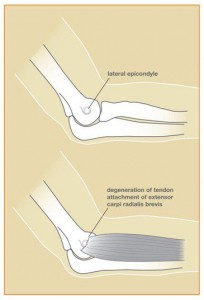Tennis elbow (lateral epicondylitis) is a painful and very common elbow problem. Tennis elbow is caused by wear and tear degeneration within the extensor carpi radialis brevis (ECRB) tendon on the outside of the elbow. Despite the name, tennis elbow is not just limited to tennis players. Tennis elbow is often diagnosed in healthy patients between the ages of 30 and 50, many of whom have never played tennis.
Patients experience pain on the outside of the elbow and often point to a very tender spot near the lateral epicondyle bony prominence. Symptoms can be aggravated by a forceful, repetitive activity with the hand and wrist, such as the tennis backhand swing or heavy gripping. Lifting light objects with the palm down, gripping the steering wheel, and even simple household activities can be painful. The majority of patients with tennis elbow improve with non-operative treatment, although symptoms may take several weeks or months to go away. Once tennis elbow goes away, it is unlikely to return. Surgery is occasionally recommended for some patients who do not improve with conservative treatment.
Non-operative Treatment Options:
- Braces: Wearing a forearm strap or wrist splint
- Activity modification: Resting; avoiding heavy lifting & forceful gripping
- Medications: Taking anti-inflammatory medications such as Motrin, Naproxen, or Tylenol for pain relief
- Stretches: Stretching the muscles of the hand, wrist, and elbow with home exercises
- Hand Therapy: A therapist can guide tennis elbow exercises and perform pain-relieving treatments such as iontophoresis
- Corticosteroid injection: Anti-inflammatory injection targeting the degenerative ECRB tissue can be used to reduce pain

